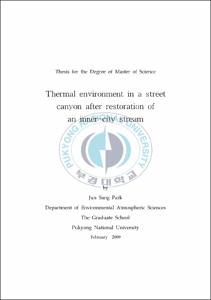Thermal environment in a street canyon after restoration of an inner-city stream
- Alternative Title
- 도시 하천 복원 후에 도시 협곡의 열 환경 변화
- Abstract
- 도시 기후는 인간 생활에 직접적인 영향을 끼치고, 인간은 도시 기후 변화에 원인을 제공하면서 상호작용을 하고 있다. 난류에 의한 지표면과 대기 사이의 질량 교환 과정은 지표면 부근에서 복사평형과 열에너지수지에 중요하게 작용한다. 도시 하천 복원 후 기온 하강의 원인은 풍속의 증가나 일사량의 변화로 분석한 사례가 있었다. 하지만 토지피복의 변화에 대한 부분을 고려치 않았고 대상 지점 선택의 통일성이 없는 문제를 가지고 있었다. 따라서 본 연구는 기온 하강의 원인을 찾기 위해 지표 변화에 따른 난류 관측을 통한 지표면 에너지 수지 관계를 연구하였다.
2003년 8월부터 2006년 8월까지 총 4회에 걸쳐 서울 청계6가의 평화시장과 아파트를 가로지르는 청계천을 SLS와 AWS 관측기기를 이용하여 난류 성분과 기온, 습도, 복사 등을 관측하였다. 또한 난류 내의 운동플럭스, 안정도, 난류 운동에너지, 열플럭스를 관측하였다. AWS 관측 결과 기온 하강을 단정하기는 어려운 부분이 있었고, 풍속은 복원 전과 후에 변화가 없었다. 하지만 풍향 관측 결과 밤에는 동풍, 낮에는 서풍으로 밤과 낮의 풍향이 반대로 관측되었다. 청계천 복원 후의 기온은 날씨의 영향으로 표준 편차를 구하여 나타낸 결과 기온이 감소하였다.
도시 하천 복원 후에 열환경은 피복의 상태에 따라 다르게 나타났고 원인을 분석하기 위해 난류 에너지를 관측하였다. 난류 성분 관측 결과 운동플럭스는 감소하였고, 안정도는 불안정도가 감소하는 결과를 보였다. 난류 운동에너지 역시 복원 후에 감소하였으며 열플럭스 또한 감소하여 나타났다. 이를 객관적으로 나타내기 위해 무차원화 하였고 복원 후 열플럭스는 감소하여 나타났다. 현열 에너지가 감소하였다는 것을 알 수 있었고 에너지 평형식에서 순복사가 일정하다 가정했을 때, 현열이 감소하면 잠열과 토양열 그리고 저장열은 증가한다. 본 연구는 인구가 도시로 집중되는 도시화의 해결을 위한 도시 계획에 하나의 지표로 삼을 수 있고, 도시 열섬 효과 해결을 위한 해결책의 하나로 제시 할 수 있다.
A total of four observations were made near the stream over a period of three years, from August 2003 to August 2006. SLS observation equipment was used to measure atmospheric turbulent flow and sensible heat flux downtown and AWS was used for meteorological factor observation. SLS measurements were taken South-North in the peace market of Cheonggye 6 Ga and AWS in Cheonggye 6 Ga on the bridge. There showed a decrease in the temperature and no significant change in the wind speed.
Thermal cameras were used to determine the influence that the land cover change had on the surface temperature. When asphalt and concrete surfaces were predominant, the average temperature was 30~35℃, but with the stream and grassland, it was confirmed that the temperature fell to 24℃.
The surface temperature affected the thermal turbulence and a surface temperature decrease led to an air temperature decrease. We measured momentum flux, stability, turbulent kinetic energy, and sensible heat flux. The momentum flux showed a decreased energy after restoration, with instability. The turbulent kinetic energy also appeared to be the highest(0.5) before restoration, decreasing to 0.1 after restoration. Finally, it was difficulty to separate the sensible heat flux from the effects of the weather. The sensible heat flux confirmed that the decrease in temperature appears to be based on the land cover change after restoration, making sensible heat flux dimensionless by the net radiation flux.
The thermal environment can explain the energy budge after restoration of the urban stream. Among the turbulent energy components, values for the net radiation and sensible heat flux were found from the sensible heat flux observations. Although latent heat flux, soil heat flux, and stored heat flux are other components in the energy balance, these could not be determined through the net radiation and sensible heat flux. We changed the sensible heat flux to temperature units to determine the difference in the observed sensible heat flux contribution in temperature. About 300 W m-2 were calculated, for a contribution of 0.3℃ in air temperature.
This study will be determined a basic cause of change temperature, when the urban stream was restored. The result of this study can help in urban development plans, allowing a consideration of the influence exerted by a new urban stream on a city's climate. It can also be used as reference data for how much energy can be conserved by the development of an urban stream.
- Issued Date
- 2009
- Awarded Date
- 2009. 2
- Type
- Dissertation
- Publisher
- 부경대학교 대학원
- Alternative Author(s)
- Park, Jun-Sang
- Affiliation
- 부경대학교 대학원
- Department
- 대학원 환경대기과학과
- Advisor
- 권병혁
- Table Of Contents
- Ⅰ. INTRODUCTION = 1
Ⅱ. BACKGROUND = 4
Ⅲ. THE RESTORATION OF THE CHEONGGYE STREAM = 9
Ⅳ. OBSERVATION = 13
4.1. Observational environment = 13
4.2. Observational equipment = 15
4.2.1. Surface Layer Scintillometer = 18
4.2.2. Net radiation = 21
4.2.3. Automatic Weather System = 24
4.3. Meteorological condition of experimental site = 26
Ⅴ. RESULTS AND DISCUSSION = 30
5.1. Temperature and wind = 31
5.1.1. Temperature = 31
5.1.2. Surface temperature = 33
5.1.3. Wind = 40
5.2. Stability = 44
5.3. Turbulent Kinetic Energy = 47
5.4. Heat flux = 51
5.5. Thermal environment of inner stream = 57
Ⅵ. CONCLUSION = 59
REFERENCE = 61
- Degree
- Master
- Files in This Item:
-
-
Download
 Thermal environment in a street canyon after restoration of an inner-city stream.pdf
기타 데이터 / 3.96 MB / Adobe PDF
Thermal environment in a street canyon after restoration of an inner-city stream.pdf
기타 데이터 / 3.96 MB / Adobe PDF
-
Items in Repository are protected by copyright, with all rights reserved, unless otherwise indicated.